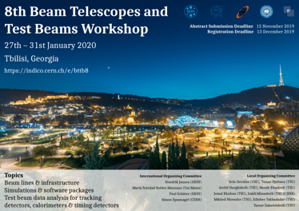Speaker
Description
The High Luminosity upgrade of the CERN Large Hadron Collider (HL-LHC) calls for new high-radiation tolerant silicon pixel sensors, capable of withstanding fluences up to 2.3E16 neq/cm2 (1MeV equivalent neutrons). In this presentation results obtained in beam test experiments with 3D pixel sensors interconnected with the RD53A readout chip are reported. RD53A is the first prototype in 65nm technology issued from RD53 collaboration for the future readout chip to be used in the upgraded pixel detectors. The interconnected modules have been tested on an electron beam at DESY, before and after irradiation, which was performed in CERN IRRAD facility, up to an equivalent fluence of 1E16 neq/cm2. The sensors were made in FBK foundry in Trento, Italy, and their development was done in collaboration with INFN (Istituto Nazionale di Fisica Nucleare, Italy). Analysis of collected data shows hit detection efficiencies around 99% measured after irradiation. All results are obtained in the framework of the CMS R&D activities.




